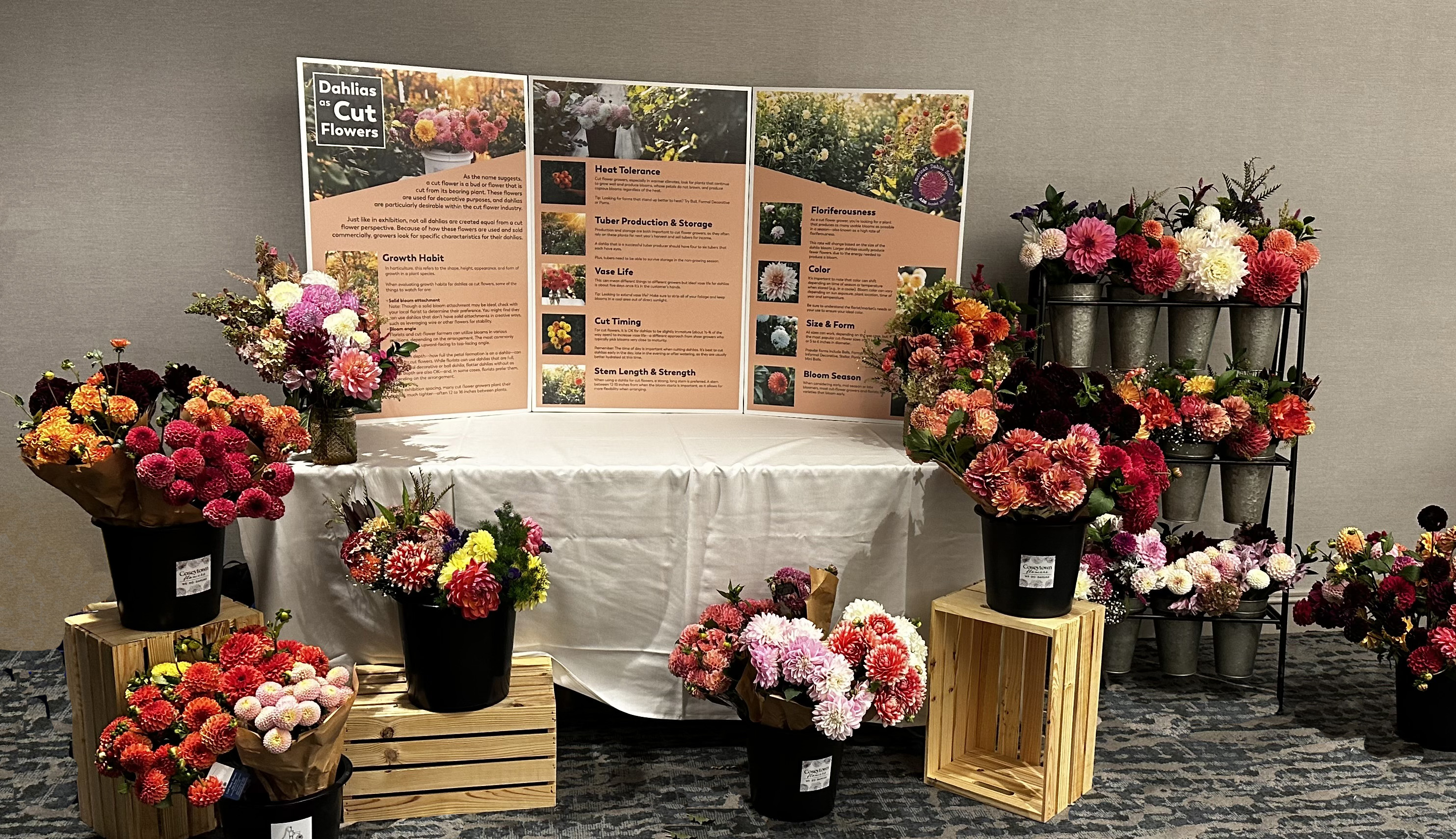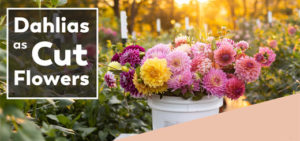New (optional) Show Class announced!
Details
As the name suggests, a cut flower is a bud or flower that is cut from its bearing plant. These flowers are used for decorative purposes, and dahlias are particularly desirable within the cut flower industry.
Just like in exhibition, not all dahlias are created equal from a cut flower perspective. Because of how these flowers are used and sold commercially, growers look for specific characteristics for their dahlias.
Find out the common characteristics of dahlias that make for a good cut flower:

Display for cut flowers at ADS National Show
Growth habit
In horticulture, this refers to the shape, height, appearance, and form of growth in a plant species.
When evaluating growth habits for dahlias as cut flowers, some of the things to watch for are:
- Solid bloom attachment
Note: Though a solid bloom attachment may be ideal, check with your local florist to determine their preference. You might find they can use dahlias that don’t have solid attachments in creative ways, such as leveraging wire or other flowers for stability.
- Bloom angle
Florists and cut-flower farmers can leverage blooms in various positions, depending on the arrangement. The most commonly used is a slight upward-facing to top-facing angle.
- Bloom depth
The bloom depth—how full the petal formation is on a dahlia—can range for cut flowers. While florists can use dahlias that are full, like a formal decorative or ball dahlia, flatter dahlias without as much depth are also OK—and, in some cases, florists prefer them, depending on the arrangement.
- Spacing
Unlike exhibition spacing, many cut flower growers plant their dahlias much tighter—often 12 to 16 inches between plants.
Floriferousness
As a cut flower grower, you’re looking for a plant that produces as many usable blooms as possible in a season—also known as a high rate of floriferousness.
This rate will change based on the size of the dahlia bloom: Larger dahlias usually produce fewer flowers, due to the energy needed to produce a bloom.
Heat tolerance
Cut flower growers, especially in warmer climates, look for plants that continue to grow and produce blooms, whose petals do not brown, and whose colors may shift.
Tip: Looking for forms that stand up better to heat? Try Ball, Formal Decorative or Poms.
Tuber production and storage
Production and storage are both important to cut flower growers, as they often rely on these plants for next year’s harvest and sell tubers for income.
A dahlia that is a successful tuber producer should have four to six tubers with eyes per plant.
Plus, tubers need to be able to survive storage in the non-growing season.
Vase life
This can mean different things to different growers but ideal vase life for dahlias is about five days once it’s in the customer’s hands.
Tip: Looking to extend vase life? Make sure to strip all of your foliage and keep blooms in a cool area out of direct sunlight.
Cut timing
For cut flowers, it is OK for dahlias to be slightly immature (about ¾ of the way open) when cut—a major difference from exhibition!
Remember: The time of day is important when cutting dahlias. It’s best to cut dahlias early in the day, late in the evening or after watering, as they are usually better hydrated at this time.
Length and strength
When using a dahlia for cut flowers, a strong, long stem—15 inches from when the bloom starts—is important, as it allows for more freedom when arranging.
Bloom season
When considering early, mid-season or late bloomers, most cut-flower growers and florists like varieties that bloom early.
Color
It’s important to note that color can shift depending on time of season or temperature when stored (e.g., in a cooler). Be sure to understand the florist/market’s needs or your use to ensure your ideal color.
Size
All sizes can work, depending on the use case, but the most popular cut-flower sizes are 3 to 4 inches or 5 to 6 inches in diameter.
Form
Popular forms include Balls, Formal Decorative, Informal Decorative, Stellar, Poms, Waterlily, and Mini Balls.

